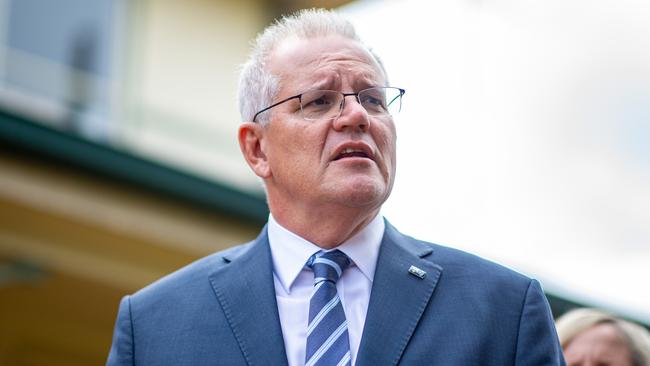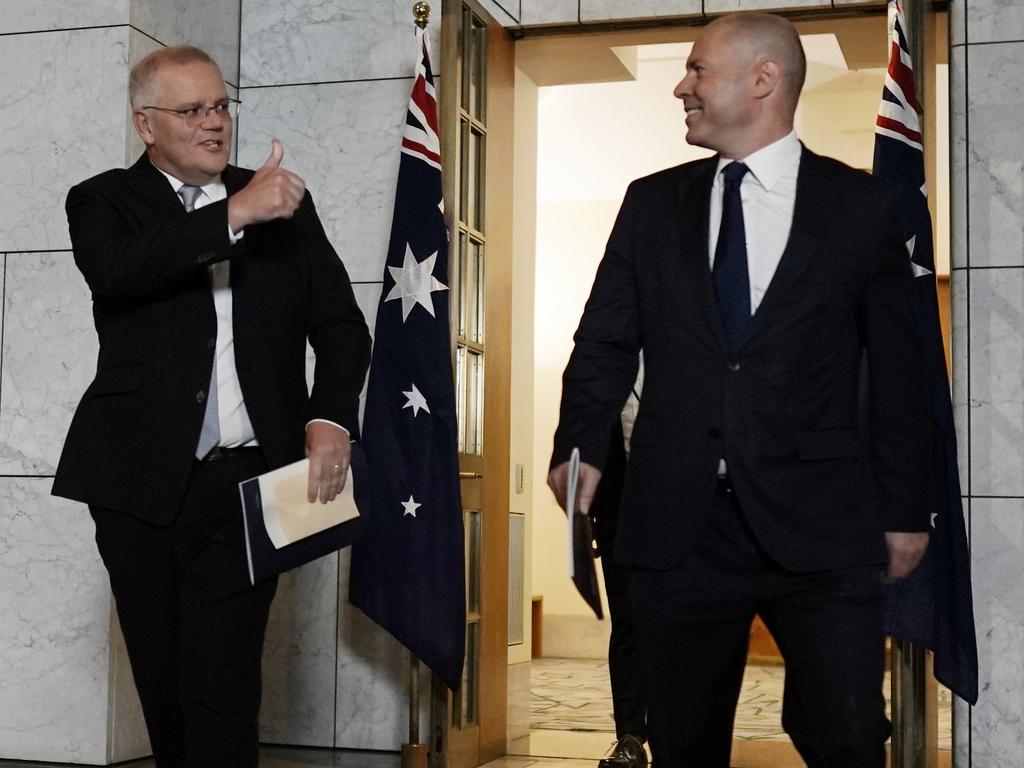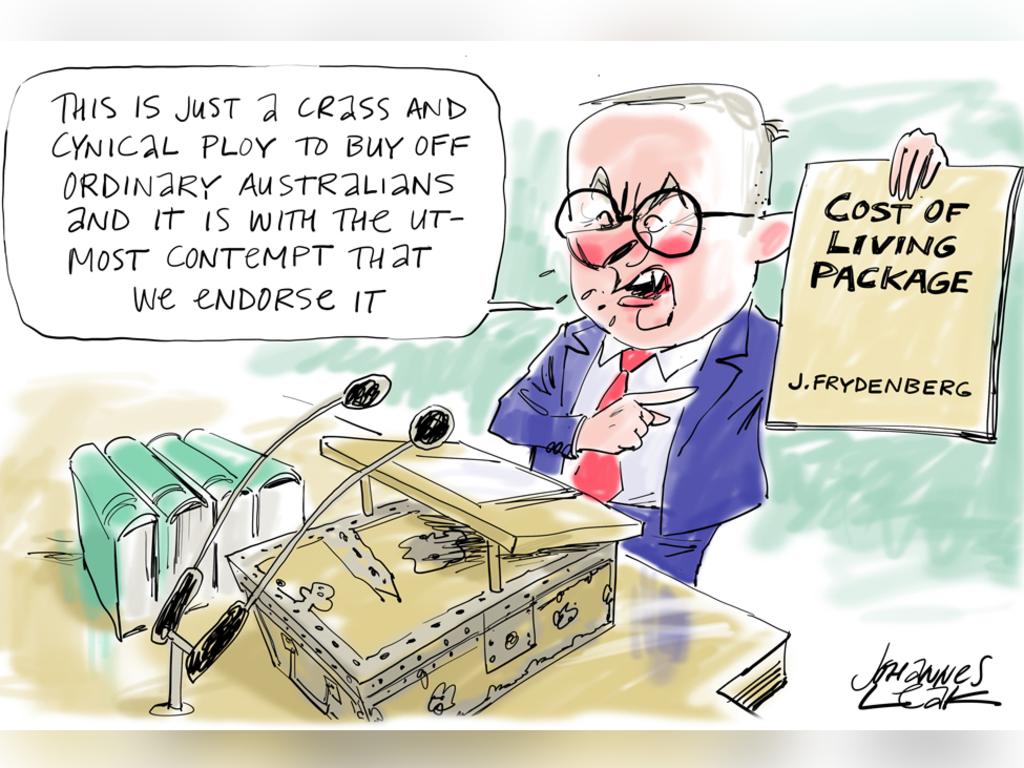Federal Budget 2022: Late ploy may not bring Scott Morrison poll joy
Voter rage runs deep, and some will pocket Josh Frydenberg’s cash and smash the incumbents anyway.

According to Josh Frydenberg, at a time of tumult the nation is a haven of low unemployment, rising wages, strong growth and falling debt. But voters don’t buy it and are playing hard to get, especially working families, young people and tradies, who price their votes as precisely as hedge fundies place their bets.
The public is not giving the Morrison government credit for economic revival, at least on the scoreboard politicians never take their eyes off. The Treasurer says the lag in opinion polls means it’s 2019 all over again. That’s the adrenaline of budget selling.
Frydenberg tried out a “blue steel” demeanour on Wednesday at the National Press Club when asked about how he would turn things around for the government. The previous evening, he had splashed $8.5bn on a cost-of-living package and clinked his glass to a $103bn improvement in the budget’s bottom line since Christmas. Will this really be enough for picky voters?
The main measures, which Frydenberg claimed were temporary, targeted and responsible, include halving the fuel excise to 22c a litre for six months, perhaps a saving of $700 for a typical two-car family; more than 10 million workers will get a one-off $420 cost-of-living tax offset this financial year; and a one-off tax-free $250 payment to pensioners, carers, veterans, welfare recipients and concession card holders.
The Treasurer declared come polling day voters would stick with the safe option because the alternative is not really who they claim to be. He said Albanese Labor might be posing as a “Mini-Me” of the Morrison government, but it remains an unreconstructed tax-and-spend re-run of the Rudd-Gillard-Shorten years.
In his budget reply speech on Thursday night Anthony Albanese zeroed-in on the soft underbelly of the Coalition’s tenure, namely wage stagnation, the flip side of the cost-of-living dynamic. Record low pay growth was a feature, not a bug, of the Coalition’s bad policy, he claimed.
“The relentless pressure of flat wages and rising prices won’t stop because of a short-term, pre-election promise,” the Opposition Leader said. “The truth is if you want real, permanent, meaningful help with the cost of living, you need a plan to get wages growing again.”
Spot on, although Albanese did not fill in the details of how he would change the pay game. He might as well have said, Wages will always be higher under Labor!
Time is running out for Scott Morrison to restore confidence among the voters who stuck with the Coalition last time. These included the blue-collar families in marginal seats in the outer suburbs and regional towns that spurned Bill Shorten’s social and economic restoration drama, where the state is your mate.
But look what happened. Government has been at the helm during the pandemic, with Canberra’s fiscal pump worth $314bn in direct support, plus almost $30bn in extra health costs. Cheap money has fuelled a boom and some voters reckon Albanese may be a safer bet to keep the good times rolling.
“More than 1000 individual decisions across all areas of government have put our economy in the strong position it is today,” Frydenberg told the NPC crowd, extolling a robust growth rate, high double-dose vaccination rate and very low Covid-19 mortality rate.
The jobless rate is about to slip below 4 per cent, consumer spending has been spectacularly strong and the broad measures of income in the national accounts reveal robust growth in disposable incomes. Treasury estimates an extra $251bn has been saved by households during the past two years.
Yet the roots of voter rage run deep this year and some will pocket Josh’s cash and smash the incumbents anyway. Australians are weary, scarred psychologically by the pandemic’s jagged rhythms, while some are fighting to shake Covid-19 lethargy months after being infected.
The rising cost of living, and how to provide meaningful relief, is the main political arena, but other issues are at play as health officials prepare for another winter of coronavirus, new variants and seasonal influenza. Remember that?
It’s a grumpy, frustrated electorate, and many are taking it out on the Prime Minister, who has been the focus of Labor’s attacks since late 2019 when the Black Summer bushfires scorched his prestige. According to Newspoll, Morrison now trails Albanese as preferred prime minister in every state except Queensland.
As we head into the official campaign, pollster John Scales tells Inquirer the Liberal Party’s brand is damaged, while there’s a palpable sense of the “tiredness of this government” as it seeks a fourth term.
“Then there’s the underlying hatred, venom if you like, from those who did not vote for Morrison in the first place,” says the founder of JWS Research.
“But then we have to look at the issues. Voters are asking who will best look after them on cost of living, the health system and hospitals, education, the economy and national security if there’s a war.”
Frydenberg’s pre-election budget is a sharp pitch to those who got the Coalition over the line in 2019 but have not been feeling the economic recovery in their household budgets because of the rising cost of everything that’s essential, especially petrol.
The cost-of-living package is being rushed out to the voters Morrison needs in his camp, especially working parents in the suburbs, who make up one-third of the electorate, are aged 35 to 54, and who don’t want their vote taken for granted. The JWS Research True Issues survey shows 74 per cent of this cohort want government action on living costs. The Coalition’s primary vote has plummeted with these voters.
Looking at the electoral pendulum of the government’s most vulnerable seats, we see several in outer suburban areas with a very high proportion of families with children. For instance, Banks and Lindsay in western Sydney, in Queensland there’s Longman and Peter Dutton’s Dickson, Boothby in Adelaide and Bass in northeastern Tasmania.
In truth, there isn’t a seat in the nation that can withstand a backlash from working families or where elevated petrol prices can be ignored by those in power. Electric vehicles just got another nudge.
The one-off tax offset, combined with the low and middle income tax offset, means some dual-income households will receive a $3000 benefit when they complete their tax returns. Again, drill into the numbers, and it’s simply middle-class welfare, helping some of those who actually don’t need a handout.
Clearly this tax bonus also benefits adults aged under 35, who may not yet be parents but are also demanding government action to reduce living costs. There are a high proportion of these voters, who also make up one-third of the electorate, in Coalition marginal seats, including Perth’s Swan and Hasluck, Sydney’s Wentworth and Reid, and Melbourne’s Chisholm, Higgins and Kooyong, which is held by the Treasurer.
The extension to 50,000 places a year of the popular Home Guarantee Scheme, which gets people into the housing market with a deposit as low as 5 per cent, is squarely aimed at this cohort. These are the folks who worry most about housing affordability and the threat of rising interest rates. Higher mortgage costs are coming.
Frydenberg also has gone hard after tradies in this budget, with a $15,000 wage subsidy making it easier for a business owner to employ an apprentice. One-quarter of businesses in the nation employ a trainee or apprentice. Workers starting out on the tools, usually still aged in their teens, will get, over several instalments, a $5000 payment.
Blue-collar workers make up a large share of the voters in Labor’s NSW Hunter heartland that Morrison is sweating on to make up for expected losses in the capitals. The Prime Minister has been spruiking high-paying jobs and investment breaks in mining, energy production and manufacturing in Hunter, Shortland and Paterson, while trying to shore-up the Coalition’s Flynn in central Queensland, La Trobe in Victoria, and Bass and Braddon in Tasmania.
But there’s trouble brewing for the Coalition in what would be regarded as relatively safe seats, given sharp falls in support among the so-called quiet Australians Morrison regards as his electoral talismans after his miracle win.
According to a demographic analysis of Newspoll results this year, the groups Morrison relied on to get him over the line in 2019 have abandoned both the Coalition and its leader. The only demographics in which the Coalition leads Labor is the over-65 age group and Christian voters.
The real pain for the Prime Minister is coming from aspirational voters. Only 29 per cent of 35 to 49-year-olds are telling Newspoll’s field agents they will give their primary vote to the Liberal-National parties, compared with 44 per cent support for Labor. Among high-income voters, the survey analysis reveals a 12-point drop in Coalition first preference votes across the past three months to 33 per cent, with Albanese now their preferred prime minister.
Long-time political observers believe the contest is much tighter than the national polls suggest. The latest Newspoll, taken three weeks ago, showed the Coalition on a primary vote of 35 per cent and Labor at 41 per cent. On a two-party-preferred split, based on preference flows from the previous election, Labor leads the Coalition 55 to 45.
Scales says the seat-by-seat analysis based on published polls shows a very different, and closer, picture than what you would find by applying the inferred swing from the national polls.
Newspoll’s pendulum suggests a national two-party swing away from the Coalition of 6.5 per cent, and a loss of 22 seats. That’s not the way things play out. The election will produce swings above and below national averages, based on head-to-head contests and the efficiency with which parties harvest votes. It will be a wild ride.
As the 46th parliament nears its use-by date, the fatigue this week among those in Canberra seeking re-election matched the exhaustion about in the community. But there’s an unmistakeable difference in the bubble’s exclusive air. Fear is palpable. Muted Labor is afraid it will stuff it up, while the cash-happy Coalition senses the end is nigh. The Coalition is a long way behind.
Scales says the basic scenario is the current primary vote average among competing national polls is about the opposite of what it was at the 2019 election, with the Coalition securing 41.4 per cent and Labor a paltry 33.3 per cent.
The veteran pollster says for the Coalition “to scratch a win, their primary vote would need to be at least equal to Labor’s and preferences come in at 50-50 or better”. Scales believes a lot rests on the 15 per cent or more non-Greens vote, as the Greens vote largely goes to Labor.
“Any way you look at it, it’s a huge mountain to climb for the Coalition,” he says.








Now is the third autumn of our discontent as budget week recedes, and preparations are revved up for the May poll. Australia is not in Covid-19’s fiercest grip, nor is the national mood anywhere near in touch with the hard numbers that reveal our propitious circumstances compared with rich-country peers.